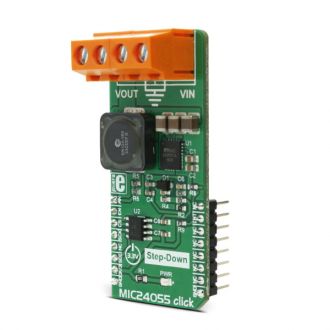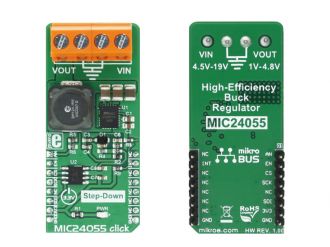
We strongly encourage users to use Package manager for sharing their code on Libstock website, because it boosts your efficiency and leaves the end user with no room for error. [more info]

Rating:
Author: MIKROE
Last Updated: 2018-01-21
Package Version: 1.0.0.0
mikroSDK Library: 1.0.0.0
Category: Buck
Downloaded: 5909 times
Not followed.
License: MIT license
MIC24055 click is equipped with MIC24055, high-efficiency buck regulator from Microchip. This click boardâ„¢ works with the wide range of input voltages - up to 19V. The regulated voltage at the output can be set from 1V to 4.8V, by the means of the feedback (FB) pin and the second chip on board - MCP4921.
Do you want to subscribe in order to receive notifications regarding "MIC24055 click" changes.
Do you want to unsubscribe in order to stop receiving notifications regarding "MIC24055 click" changes.
Do you want to report abuse regarding "MIC24055 click".


Library Description
The library contains functions for basic control of the onboard DAC.
Key functions:
void mic24055_dacOutput(uint16_t valueDAC)- Directly sets the DAC output voltage
void mic24055_setVout(uint16_t voltage)- Sets the output voltage
Examples Description
The application is composed of three sections :
mic24055_setVout(500);
mikrobus_logWrite("Setting Vout to 500mV",_LOG_LINE);
Delay_ms(3000);
mic24055_setVout(2300);
mikrobus_logWrite("Setting Vout to 2300mV",_LOG_LINE);
Delay_ms(3000);
Other MikroElektronika libraries used in the example:
Additional notes and information
Depending on the development board you are using, you may need USB UART click, USB UART 2 click or RS232 click to connect to your PC, for development systems with no UART to USB interface available on the board. The terminal available in all MikroElektronika compilers, or any other terminal application of your choice, can be used to read the message.